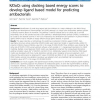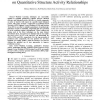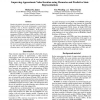416 search results - page 1 / 84 » Improving the Development of QSAR Prediction Models with the... |
ENGL
2008
13 years 4 months ago
2008
The improvement on the QSAR prediction of the trans-stilbenes affinity for the -amyloid peptide (employed for detecting the Alzheimer disease) achieved by means of using approximat...
BMCBI
2010
2010
KiDoQ: using docking based energy scores to develop ligand based model for predicting antibacterials
13 years 4 months ago
Background: Identification of novel drug targets and their inhibitors is a major challenge in the field of drug designing and development. Diaminopimelic acid (DAP) pathway is a u...
CIBCB
2009
IEEE
13 years 5 months ago
2009
IEEE
Machine Learning techniques are successfully applied to establish quantitative relations between chemical structure and biological activity (QSAR), i.e. classify compounds as activ...
BMCBI
2006
13 years 4 months ago
2006
Background: Modelling the interaction between potentially antigenic peptides and Major Histocompatibility Complex (MHC) molecules is a key step in identifying potential T-cell epi...
AAAI
2006
13 years 5 months ago
2006
Planning in partially-observable dynamical systems is a challenging problem, and recent developments in point-based techniques such as Perseus significantly improve performance as...



